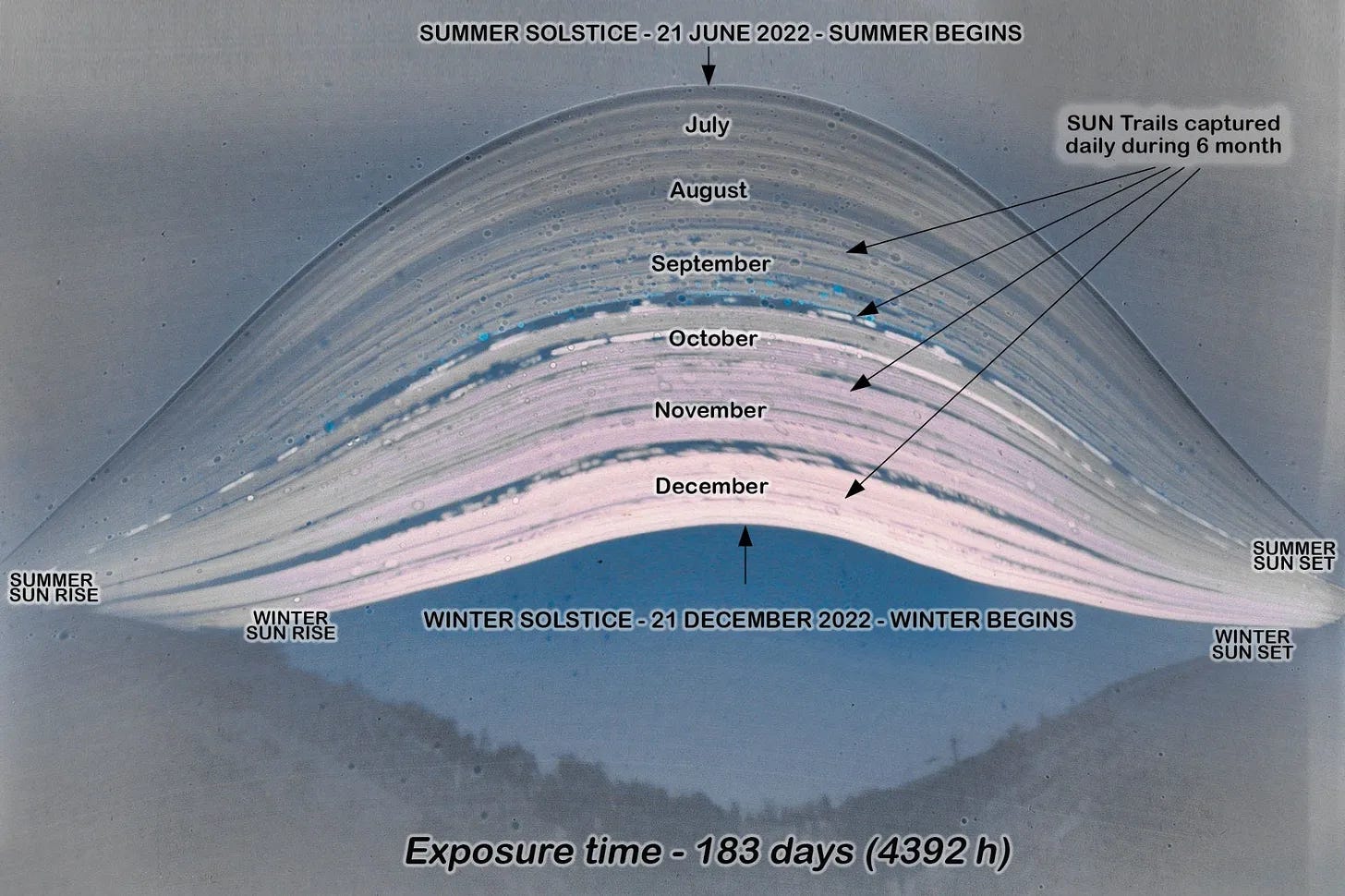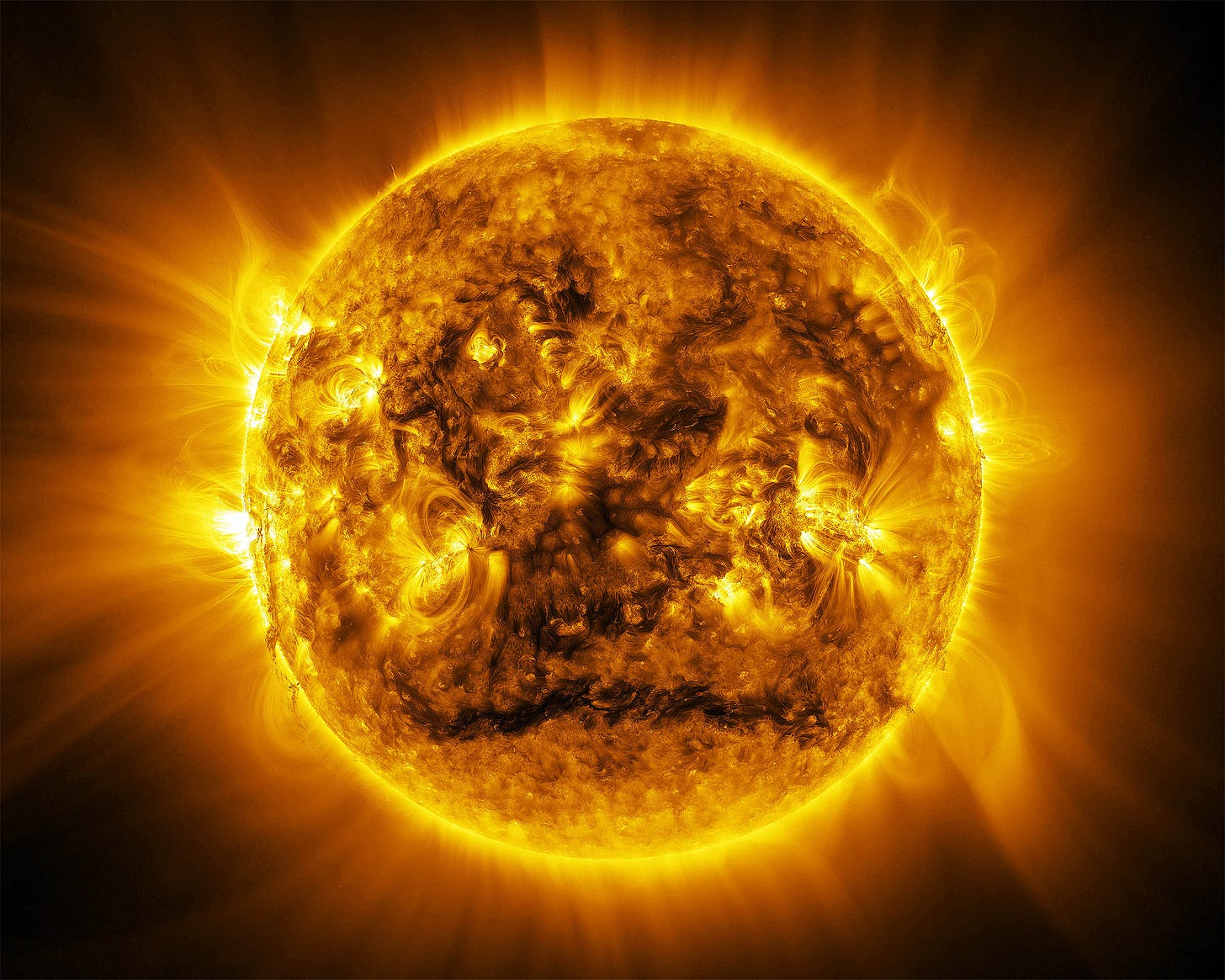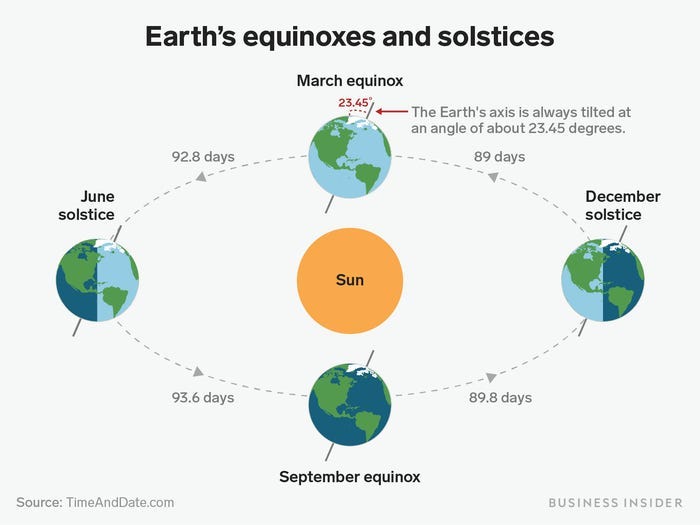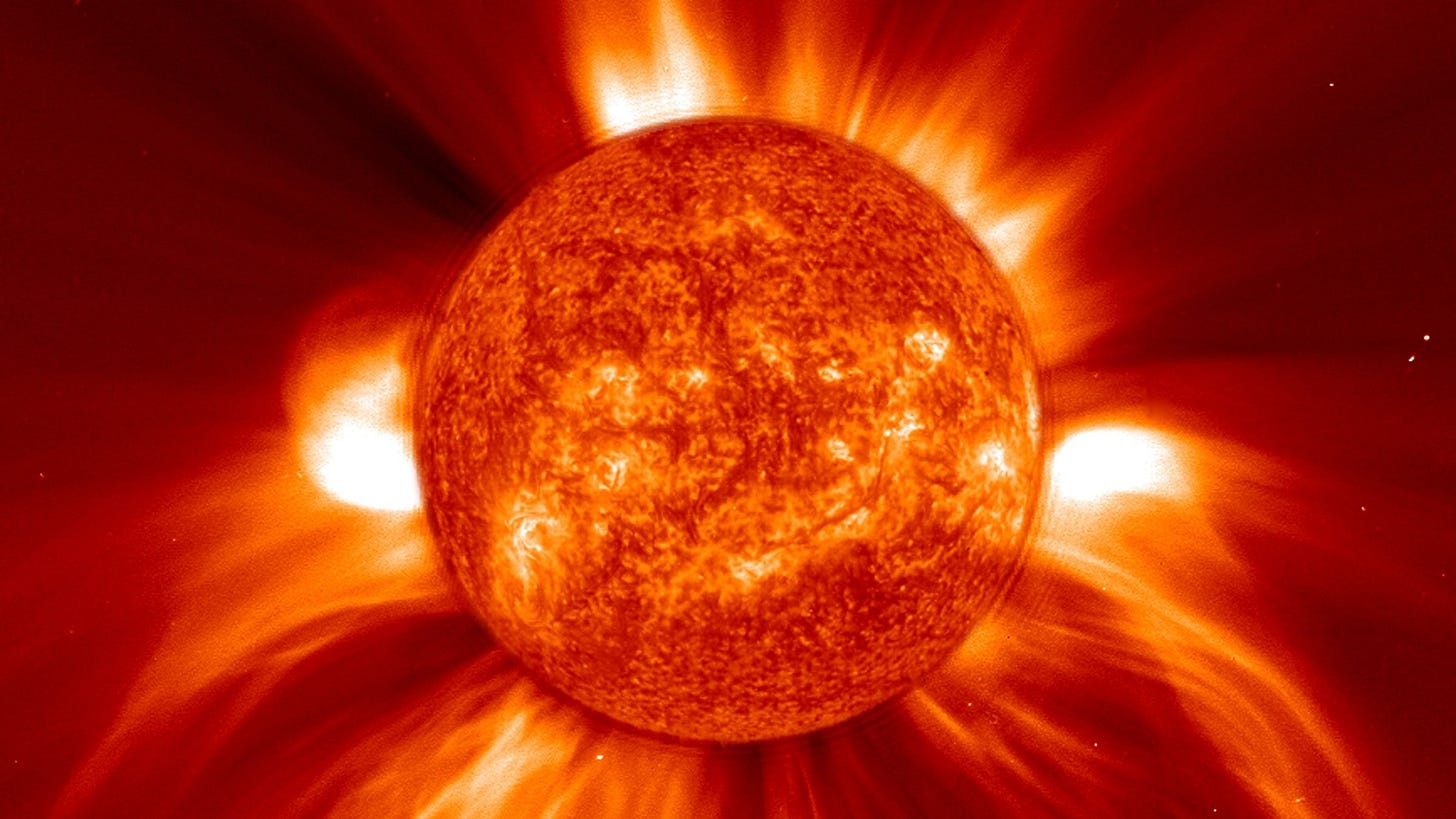Hello everyone:
Some sharp-eyed readers will notice in this week’s celebration of the solstice some borrowed material from previous solstice notes. These twice-annual notes are more rite than essay, and so build on previous versions, but this piece does have its own path. Enjoy.
As always, please remember to scroll past the end of the essay to read some curated Anthropocene news.
Now on to this week’s writing:
Happy Solstice to you all. May you find some peace and purpose in this celestial moment. It’s good to be able to focus on something larger and more stable than the turbulence of this era. It is an extraordinary time to be alive, but it is a bit much.
Tomorrow (Friday, June 20th) at 10:42 p.m. (EST), the length of daylight in the northern hemisphere will reach its maximum, and days in the southern hemisphere will end their decline. Thereafter, the pendulum begins the swing back. Here in the north, as summer begins, so does our slow retreat into shorter days and longer nights.
As with all things, the end of the season is born alongside its beginning.
The tilted axis of the Earth, as it makes its solar orbit, creates these twinned seasons of light and dark that define life in temperate and polar latitudes. If you’re not sure how to imagine what’s going on in the solar system, here’s a useful illustration of our home’s relationship with its home, the Sun. The relative sizes of tiny Earth and the massive Sun are way off, and it doesn’t show the Earth rotating on its axis, but it nicely articulates the orbit:
As I reminded myself and you last December, a solstice is less an event than an imagined pause, as quietly momentous as the shift between tides.
Like the sea at its fullness, here in the north the Sun will seem to stop - solstice is rooted in the Latin sol “sun” and sistere “to stand still” - in its six-month flow of increase until, sated, it will begin to lower in what we imagine is its path across our sky. Here’s what that decline looks like, in a pinhole camera solargraph from Portugal that recorded a view of our movement past the Sun every day from summer solstice to winter solstice:

The solar reality is, of course, always a turbulent burning stillness. The Sun, unmoving, has no path but shines outward in all directions in a generous radiance. We are the ones in motion. The Sun is the warm soul around which this blue-green body of life spins in its annual devotional path. You and I and ferns are merely light-dependent particles in that orbit.
So much of life on Earth (in the temperate and polar zones) hinges on this annual tide of light. The living soil warms, plant communities awaken, insects rise to join with them, fish and amphibians move to the ice-free surface, birds fly thousands of miles to feed on and ornament the dance, and resident predators await the bounty.
The sun fuels all of life, which means that every ecological community is a conversation about light. It’s worth pausing with the solstice to think about how best to live in a way which honors that conversation. After all, from the miracle of photosynthesis and the rhythm of seasonality we build our bodies, our families, our societies, our economies, and our wobbly empires.
For guidance, perhaps we should look to the ferns, which have been talking elegantly with the light for 400 million years.
It’s never quite felt right to me that the onset of summer is also the starting line in the darkening path to winter, but that’s just because my mind is still more attached to the long summer days of childhood than to the lessons of basic astronomy. Our consciousness is a structure built with stories, after all. And because we’re an altricial species (one whose young require raising), and because we’re imaginative apes unhappy with our mortality, science is never our first or last storyteller. Love and fear take turns at that job.
But science tells many of the most beautiful tales, if we pay attention. More and more, for example, I think that we should be deeply and daily aware of the Sun, as an object of both study and reverence. As I wrote in “The Sun Within,”
Why we stopped worshiping the Sun I cannot fathom. It’s the beautiful, dangerous, and life-giving center of our lives, of all life. It’s everything to us, and we are nothing to it except strange grasping creatures conscious enough to study its physics but foolish enough not to live simply under its beneficent rule.
Is there anything in this life more profoundly physical and metaphysical than the Sun’s light amid the darkness? We need not look anywhere else than the solar system’s burning heart for this shining truth: All matter is borrowed energy.
…Our awe, our science, and the proud cognition that drives both are only weird features of an odd ape (that’s us) on a mere twig in the tree of life. We’re charismatic but unnecessary megafauna on a minor planet which, when added to the other planets and everything else orbiting the Sun, make up only 0.14% of the mass in the solar system. The other 99.86% is the burning mass of hydrogen and helium we should be praying to. The Sun is the star.
In this era of catastrophic anthropogenic change, how might we best use our borrowed energy from the Sun? We could start by gathering its energy directly rather than by mindlessly burning millions of years of the oldest testaments to its power. We could reduce both the energy we use and the things we have come to believe are necessary for our lives.
Most importantly, perhaps, we could act in accordance with a fundamental truth: The Sun’s energy is far more useful stored in an abundance of plants, animals, and fungi than locked up in our abstract antibiotic technologies. We could aim to be like fireflies who modestly resemble stars in their glistening, rather than trying to outshine them with a civilization as infernal as an adolescent’s bonfire.
The fireflies are out now here in our little corner of the Maine coast, but there aren’t many of them. Still, I try to take a moment before bed to watch them speak in sparks and arcs of code. Their silent chatter tells us that life in the Anthropocene is still here and pulsing with the intent to perpetuate itself, so long as conditions allow.
So long as conditions allow… The Anthropocene means that humans are, for the foreseeable future, the prime mover in setting the conditions for life on Earth. What we do matters to every other species. Or, more to the point, what we decide to do or not do matters. There’s not much time left to redirect civilization in a way that will preserve at least a moderately abundant Earth for our great-grandchildren.
But brevity is not impossibility. Witness the fireflies, who have evolved a mating strategy which relies on making light on the shortest nights of the year. It seems counterintuitive, but it works beautifully. And has worked beautifully for millions of years.
We should be so lucky. Solstices aside, beginnings and endings are not what they used to be. To ensure that we (and a vibrant community of life) will be around for the long haul, we’d better start moving.
Ironically, that moving forward requires some standing still. We’re in need of some restraint. A habit of stillness to acknowledge the light of the Sun above us, and the lights of the fireflies around us, would be a good start. The good news is that modesty comes with awe, and awe comes naturally if a) we recognize our place under the Sun, and b) we become more comfortable with our mortality, our winking out of this beautiful existence.
Dylan Thomas wove himself into the whole fabric when he wrote “The force that through the green fuse drives the flower”:
The force that through the green fuse drives the flower Drives my green age; that blasts the roots of trees Is my destroyer.
But I prefer his more cheerful ode to childhood in “Fern Hill,” in which death is present at the beginning and joy is the antidote to dread:
Under the new made clouds and happy as the heart was long,
In the sun born over and over,
I ran my heedless ways...
Oh as I was young and easy in the mercy of his means,
Time held me green and dying
Though I sang in my chains like the sea.Singing in our chains is all we can do, really. We’re borrowed from the Sun and given to the Earth. We each have our own tide of darkness and light, and our own tilt as we make our orbit.
The more we listen to the Earth breathing through its ancient cycles, the more we can remember to breathe with it. Here’s an Arctic glance at that seasonal breathing, with snow and ice forming and unforming as light pulses across the Pole from solstice to solstice:
I hope you find a moment to stand still and acknowledge the solstice. I’m not much for rituals, but I try to remember where I live once in a while. And it’s easy enough to pause on a late afternoon walk, or while sitting on a porch, and remember that the journey we’re on, even in dark times, is always infused with light. Better yet, it’s good to remember that the light we love is what we’re made of.
Thanks for sticking with me.
In other Anthropocene news:
From Emergence, in “Fire in the Belly,” Tyson Yunkaporta articulates the problem of “overthinking and underfeeling” our existence, through his lens as an Aboriginal scholar and writer wrestling with his displacement from tradition and history. The essay is rich with complicated wisdom, and well worth your time. If we want to live in right relation to the land, he says, we need to think more with our gut:
Individualistic thinking is never enough to sustain life. That’s why our custodial species has developed two brains—one for thought and one for thinking-feeling.
From Nautilus, “Hope Catches a Tailwind,” an interview with an ocean advocate Dona Bertarelli, who has spent her life at sea. She now spends her time working to make all good words nations have offered for marine conservation into good deeds:
I do see hope. We know what works. Where marine protection is robust, biodiversity is recovering. But it takes time, funding, and sustained political will. Too often, lengthy scientific studies and underfunded campaigns are required to justify conservation, while destructive practices continue unchecked and without precaution. It’s time we reverse that burden. Conservation should be the default, and those seeking to extract must prove they will do no harm. Real progress depends on a diverse ecosystem of collaboration, from scientists and policymakers to Indigenous communities, coastal populations, youth leaders, and the private sector.
From the Guardian, amid the slashing of funds from the U.S. federal government, the Miccosukee tribe in Florida is stepping up efforts to conserve 18 million acres in partnership with the Florida Wildlife Corridor Foundation. It is, they say, their “moral obligation.”
From the Times, because of particular ocean currents, mercury levels have been rising steadily in Arctic waters and wildlife, and seem likely to continue rising even as global mercury emissions are on the decline.
From Yale e360, lightning is becoming much more common in the warming Arctic, and researchers are racing to figure out what the consequences will be.
From Undark, “Uncovering the Exposome,” an article on a wildly ambitious but necessary new field of environmental health research that seeks to map the hazards we’re exposed to and their consequences for our bodies. Here’s a fuller description:
The work aims to understand human health outcomes by cataloguing the tens of thousands of chemicals and conditions a person is exposed to over the course of their life and determine how those interactions affect their unique biology, a concept referred to as the exposome.
Also from Undark, Norway has made an astonishingly successful switch to electric cars, with some 90% of the new car market, but it’s unclear whether many other countries will follow their model.











Beautifully said Jason, I love how this important solar event sparks masterful words to rise and become best supporting actors or actresses, best original screenplay, but our lifetime achievement award the star of the show, goes to ;The Sun.
“The more we listen to the Earth breathing through its ancient cycles, the more we can remember to breathe with it.”
Thank you, Jason, still not too late for me to acknowledge the breathing earth (amazing! ) and stop and give thanks to the Sun , and wish you and Heather, a Happy Summer Solstice celebration 10:42pm!
Your beautiful writing underscores the gracefulness of these quiet natural rhythms, such as the earth moving around the sun, with its power and nuance working in tandem. Thank you for this lovely call to observe and revere.